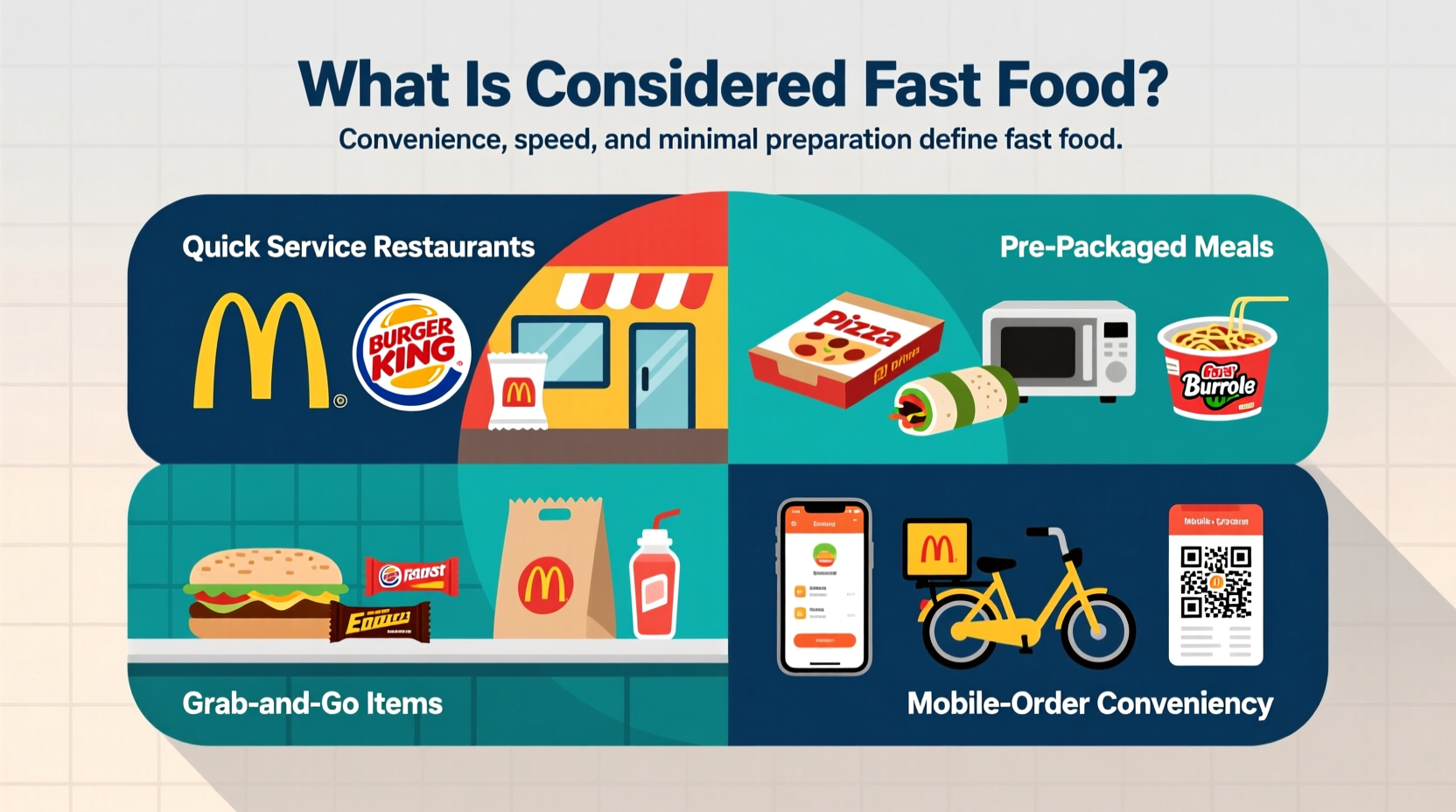Understanding what qualifies as fast food helps consumers make informed dietary choices and recognize industry trends. This guide cuts through confusion with clear definitions, historical context, and practical examples you can use immediately.
Core Characteristics That Define Fast Food
Fast food isn't just about speed—it's a specific business model with identifiable traits. When determining what is considered fast food, look for these four essential elements:
- Speed-to-service: Orders prepared in under 5 minutes for most items
- Standardized menus: Identical offerings across all locations
- Counter service model: Minimal or no table service
- Consistent branding: Recognizable logos and packaging worldwide
These characteristics distinguish fast food from other quick-service categories. For instance, a local deli making custom sandwiches might be quick, but without standardized menus and national branding, it doesn't qualify as fast food.
How Fast Food Differs From Other Quick Service Categories
| Food Category | Preparation Time | Menu Standardization | Service Model |
|---|---|---|---|
| Fast Food | Under 5 minutes | Identical nationwide | Counter only |
| Casual Dining | 15-25 minutes | Regional variations | Full table service |
| Fast Casual | 8-12 minutes | Some customization | Hybrid service |
This comparison clarifies common misconceptions. Many people wonder is pizza considered fast food—the answer depends on the establishment. Domino's with its 30-minute guarantee qualifies, while a local pizzeria making custom pies does not.
Evolution of Fast Food: A Historical Timeline
The concept of quick-service food has evolved significantly. Understanding this timeline helps identify what is considered fast food in contemporary contexts:
- 1921: White Castle establishes the first fast food chain with standardized sliders
- 1948: McDonald's brothers pioneer the "Speedee Service System" in San Bernardino
- 1955: Ray Kroc franchises McDonald's nationally, creating the modern fast food model
- 1960s-70s: Drive-thrus and national advertising campaigns expand the industry
- 1980s-90s: Global expansion brings fast food to 100+ countries
- 2000s-present: Health-conscious options and digital ordering transform the sector
According to the National Restaurant Association's 2023 industry report, the modern fast food sector generates over $350 billion annually in the United States alone, demonstrating how deeply embedded these characteristics have become in food culture.

Common Fast Food Categories and Examples
When evaluating what is considered fast food, these categories consistently meet the defining criteria:
- Burger chains: McDonald's, Burger King, Wendy's
- Fried chicken: KFC, Popeyes, Chick-fil-A
- Pizza delivery: Domino's, Pizza Hut, Papa John's
- Taco specialists: Taco Bell, Chipotle (borderline fast casual)
- Coffee & baked goods: Starbucks, Dunkin'
These establishments maintain consistent preparation methods whether you're in New York or Tokyo. The Food and Drug Administration's Fast Food Facts report confirms that standardized recipes and cooking procedures are mandatory across all franchise locations.
Boundary Cases: What Doesn't Qualify as Fast Food
Not all quick meals meet the definition of fast food. Understanding these boundaries prevents common classification errors:
- Food trucks: While fast, most lack standardized menus across locations
- Cafeteria-style restaurants: Require more preparation time and offer customization
- Local diners: Typically have unique menus and full table service
- Prepared grocery items: Rotisserie chicken lacks the branding element
Many consumers mistakenly believe is Chinese food considered fast food. Authentic Chinese restaurants with chef-prepared dishes don't qualify, though chains like Panda Express with standardized menus do fit the definition.
Global Variations in Fast Food Definitions
The core characteristics remain consistent worldwide, but regional adaptations affect what is considered fast food in different markets:
- Japan: Conveyor belt sushi chains like Kura Sushi qualify as fast food
- Mexico: Taco stands with standardized offerings meet the criteria
- India: Quick-service chaat and dosa chains follow the model
- France: Crêperies with counter service and standardized menus
The USDA's Global Food Security report notes that fast food penetration varies significantly by region, with urban areas showing 300% higher adoption rates than rural communities worldwide.
Why the Definition Matters for Consumers
Recognizing what qualifies as fast food helps with:
- Nutritional awareness: Fast food typically contains higher sodium and fat levels
- Budget planning: Understanding portion consistency across locations
- Cultural literacy: Recognizing global food trends and their origins
- Business decisions: For entrepreneurs considering franchise opportunities
When you understand the specific criteria that define fast food, you can make more informed choices about where and what to eat—whether you're traveling abroad or exploring new dining options in your neighborhood.











 浙公网安备
33010002000092号
浙公网安备
33010002000092号 浙B2-20120091-4
浙B2-20120091-4